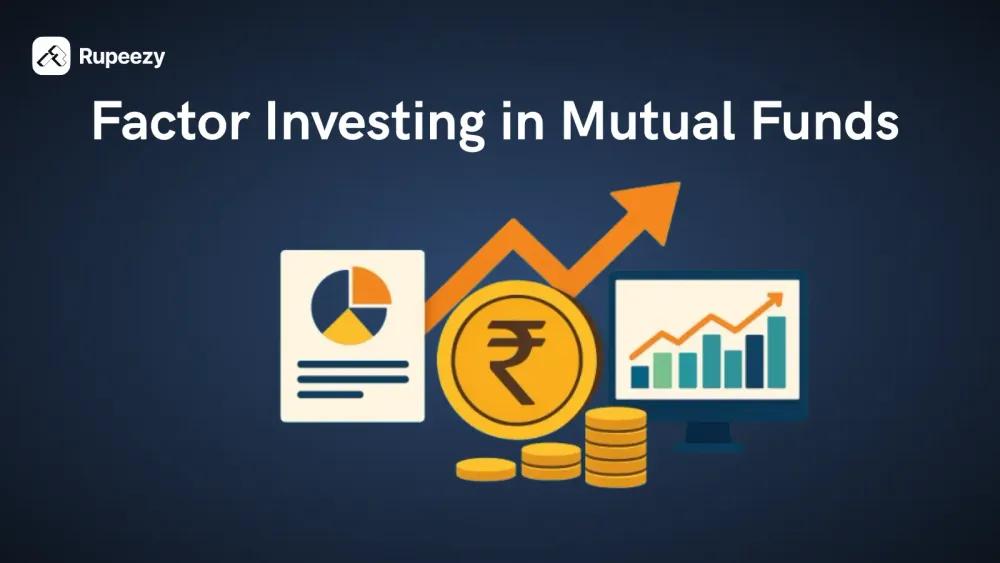Factor Investing in Mutual Funds: Meaning, Strategy & Benefits


00:00 / 00:00
The way we invest is changing rapidly; it's no longer just about picking stocks, but about understanding the factors that influence their performance. This is the thinking behind Factor Investing, a smart investment strategy based on data and research. Recently, the AUM (Assets Under Management) of factor-based mutual funds in India has surged from Rs.6,800 crore to over Rs.37,000 crore. In this blog, we will understand what factor investing is and how it is transforming the future of mutual fund investing.
What is Factor Investing?
Factor investing is a data-driven or rule-based investment strategy in which stocks are selected based on certain characteristics or “factors.” These factors are criteria that influence a stock's performance, such as Value, Quality, Momentum, Size, and Volatility. In simple terms, this approach attempts to understand why some stocks perform better than others over the long term.
Factor investing Example :
Imagine investing is like preparing a recipe. Each “factor” is an ingredient in that recipe. For example, the Value factor selects undervalued but good stocks, the Momentum factor focuses on trending stocks, and the Quality factor focuses on strong companies. When these factors are combined in the right proportions, a balanced and risk-controlled portfolio is created.
Evolution of Factor Investing
The Genesis of Factor Investing:
Factor investing has its roots in academic research. It was formally introduced in the 1990s by economists Eugene Fama and Kenneth French. They found that certain "factors" such as Market Risk, Size (Small vs. Large Companies), and Value (Undervalued Stocks) play a significant role in explaining a stock's returns. This model was later expanded to include factors like Profitability and Investment Patterns, which is now known as the Five-Factor Model.
The Journey from Global to Local:
Initially, this strategy was adopted only by institutional investors, i.e., large funds and pension plans. However, with the development of technologies such as data analytics, artificial intelligence, and machine learning, this model has become accessible to retail investors through mutual funds and ETFs.
Also Read: Top 10 Smart Beta ETFs in India
The Rise of Factor Investing in India:
Factor-based investment strategies have gained significant popularity in India over the past few years. Leading asset management companies such as Motilal Oswal, ICICI Prudential, Nippon India, and DSP Mutual Fund have launched several Smart Beta or Factor-Based Mutual Funds.
Its Significance for Indian Investors:
Factor investing is important for Indian investors because it offers a structured and scientific investment approach that differs from traditional styles. It not only reduces risk but also helps in bringing stability to returns, especially during times of increased market volatility.
Key Factors That Drive Investment Performance
The true essence of factor investing lies in these "factors," which are criteria that determine the return and risk profile of a stock.
Value Factor :
This factor identifies stocks that are trading below their intrinsic value. That is, the market has "undervalued" them. Such stocks are identified using metrics such as the P/E (Price-to-Earnings) or P/B (Price-to-Book) ratio.
Objective: To buy good stocks at a low price and profit from their value appreciation in the future.
Momentum Factor :
This factor focuses on stocks that have been consistently rising in recent months—that is, those that have a positive price trend.
Objective: To invest in stocks with strong and consistent momentum, operating on the principle that "the trend is your friend."
Quality Factor :
The Quality Factor selects companies with strong balance sheets, low debt, and consistently growing profits.
Objective: To provide investors with the opportunity to invest in stable and reliable companies that deliver sustainable returns over the long term.
Low Volatility Factor :
This factor prioritizes stocks that experience less price fluctuation. This means these stocks don't fall as much even during market downturns.
Objective: To provide stability for investors who want to take on less risk.
Size Factor :
This factor targets small-cap and mid-cap companies because historically, they have been observed to grow faster than large-cap companies.
Objective: To achieve better long-term returns by investing in smaller companies with high growth potential.
What is Factor Investing in Mutual Funds?
In mutual funds, Factor Investing means selecting stocks based on data-driven factors rather than a fund manager's personal opinions or emotions. This strategy is entirely based on research, quantitative models, and statistical analysis.
How this model works :
Each factor (such as Value, Quality, Momentum, or Low Volatility) is assigned a score, and the portfolio is constructed based on these scores. This ensures that investment decisions are based on facts rather than emotions. For example, a “Quality + Momentum” based fund invests in companies with strong financials and consistently rising share prices.
The role of Smart Beta Funds:
These factor-based mutual funds are often called Smart Beta Funds because they track an index like traditional passive funds, but also attempt to achieve better returns like active funds.
How Does Factor Investing Work?
Factor investing is based not on emotional decisions, but on solid data and statistical analysis. Every step is carefully planned to ensure investors receive stable and consistent returns.
Selecting the Factor :
First, the investment strategy is determined, such as Value, Quality, Momentum, or Low Volatility. For example, if an investor wants stable returns, the "Low Volatility" factor might be chosen, while an investor seeking growth might opt for the "Momentum" factor.
Screening the Stocks :
Next, a quantitative model or algorithm selects companies based on data that meet the criteria of the chosen factor. For example, for the Quality factor, companies are selected based on metrics such as Return on Equity (ROE), Debt-to-Equity Ratio, and Profit Margins.
Portfolio Construction :
Once eligible companies are selected, a diversified portfolio is constructed from them. The weighting is either equal for all stocks or based on how closely each stock aligns with the chosen factor. The objective is to achieve stable returns while spreading the risk.
Periodic Rebalancing :
Markets change over time, so factor-based portfolios are regularly reviewed and rebalanced. Stocks that no longer meet the criteria are removed, and new ones are added.
Benefits of Factor Investing in Mutual Funds
Data-Driven Decisions :
Factor investing is built on decades of financial research. Numerous global studies, including the Fama-French model, have proven that certain factors, such as Value, Quality, and Momentum, deliver consistent and superior returns over the long term. This makes investing scientific and transparent.
Diversified Risk Exposure :
Factor investing does not rely on any single sector or company. When a portfolio includes different factors, the risk is automatically diversified. This reduces the impact of market volatility and leads to more stable returns.
Behavioral Edge :
Many investors make poor decisions influenced by market downturns or rumors. Factor investing eliminates this human bias because decisions are based entirely on data and algorithms. In other words, the process is followed instead of emotions.
Customizable Strategy :
Every investor has different objectives; some seek stability, while others prioritize growth. In factor investing, you can choose factors according to your objectives. For example, Low Volatility is suitable for risk-averse investors, while Momentum is a better option for those seeking growth.
Consistent Long-Term Results :
Data from the past several years shows that multi-factor portfolios deliver more stable and balanced returns compared to single-factor or traditional funds. This strategy can withstand market cycles over time.
Risks and Limitations of Factor Investing
Factor Cyclicality :
Not every factor performs well all the time. For example, the Value Factor tends to perform well when the market is stable, while the Momentum Factor performs better in a bull market. This means that the performance of factors can change over time.
Risk of Overfitting :
Sometimes, fund managers or models try to combine too many factors at once. This may make the data look good, but the results in the real market can be weak. This is called overfitting.
Limited Domestic Data :
Factor investing is still a relatively new concept in India. Compared to foreign markets, the history of Indian data is shorter, making it difficult to conduct long-term evaluations of the stability of certain factors.
Market Timing Risk :
Many investors keep switching between factors, trying to predict which one will perform best at any given time. This frequent switching can reduce returns and undermine the original objective of the investment.
Need for Discipline and Patience :
Factor investing is not a "quick-profit" strategy. Investors who adopt it need to stay invested for the long term to see real benefits after going through the cycles of the factors.
Factor Investing vs. Traditional Investing
Parameter | Traditional Investing | Factor Investing |
Decision Process | Based on the fund manager's or investor's opinion, experience, and market sentiment. | Completely based on data, research, and quantitative models. |
Primary Objective | Beating the benchmark or earning higher returns through market timing. | Capturing the factors that influence returns in the long term. |
Risk Exposure | High, because decisions are subjective. | Controlled and measured, because the risk is predefined. |
Transparency | The fund manager's strategy is not entirely clear. | Moreover, the factors and models are predetermined and publicly available. |
Cost/Expense Ratio | Generally, it costs more because active management is involved. | Medium or low, because it is a systematic and semi-automatic method. |
Consistency | It can be influenced by market sentiment. | More stable based on data rather than emotions. |
Time & Discipline | Subject to frequent changes and market timing. | Based on long-term discipline and patience. |
Best Suited For | Experienced investors who can time the market | Investors who want a stable, logic-based and long-term strategy. |
How to Start with Factor Investing
Assess Your Risk Profile :
Every investor has a different risk tolerance. If you are a conservative investor, Low Volatility or Quality Factors would be suitable. On the other hand, if you are an aggressive investor, Momentum or Size Factors might be better options.
Choose the Right Mutual Fund :
In India, several fund houses are now offering factor-based mutual funds or smart beta funds. You can invest in these based on your chosen factor. You can easily compare various factor-based mutual funds on Rupeezy and start investing in the right fund according to your needs.
Start with Small Investments (Start Small with SIP) :
Factor investing is a long-term strategy, so start with small SIPs (Systematic Investment Plans). This will help you better understand market cycles and gradually build a strong portfolio.
Evaluate Performance Over the Long Term :
The results of factor investing are not immediate. It's essential to give it at least 3–5 years. This will help you understand how your chosen factor performs in different market phases.
Start Investing with Rupeezy :
If you're looking for a reliable platform where investing in factor-based mutual funds is easy, transparent, and technology-backed, then Rupeezy is the right place for you.
0% Commission Mutual Funds: You can invest directly in mutual funds without any extra charges.
Smart Explore Tool: This feature allows you to compare factor-based and other funds based on your investment goals and risk profile.
MF Lab: An advanced analytics tool that helps you gain a deeper understanding of historical data, fund performance, and factor analysis.
Simplified Experience: The entire process is 100% digital, easy to use, and research-backed.
Conclusion
Today, the world of investing is smarter than ever before, and factor investing is leading that transformation. This approach relies not on guesswork or emotions, but on solid data and discipline. Its goal is to create stable, logical, and sustainable investments. If you're looking for thoughtful balance and reliable growth in your portfolio, factor investing can be a strong starting point.
FAQs
Q1. What is Factor Investing?
It's an approach where stocks are selected based on data and specific characteristics (factors), rather than guesswork.
Q2. How is it different from traditional investing?
Traditional investing relies on experience, while factor investing is entirely based on data and research.
Q3. Is Factor Investing good for beginners?
Yes, it's a better option if you want to invest wisely for the long term.
Q4. Do factor funds give better returns?
Yes, in the long run, these funds can provide more stable and balanced returns.
Q5. How long should I stay invested?
Stay invested for at least 3 to 5 years to see the effect of the factor strategy.
The content on this blog is for educational purposes only and should not be considered investment advice. While we strive for accuracy, some information may contain errors or delays in updates.
Mentions of stocks or investment products are solely for informational purposes and do not constitute recommendations. Investors should conduct their own research before making any decisions.
Investing in financial markets are subject to market risks, and past performance does not guarantee future results. It is advisable to consult a qualified financial professional, review official documents, and verify information independently before making investment decisions.

All Category









